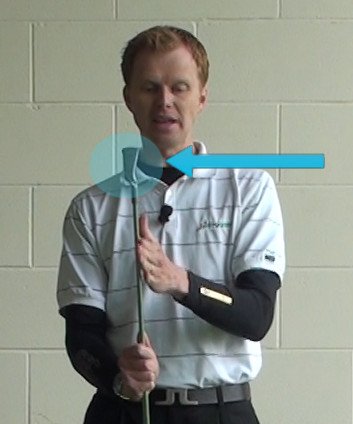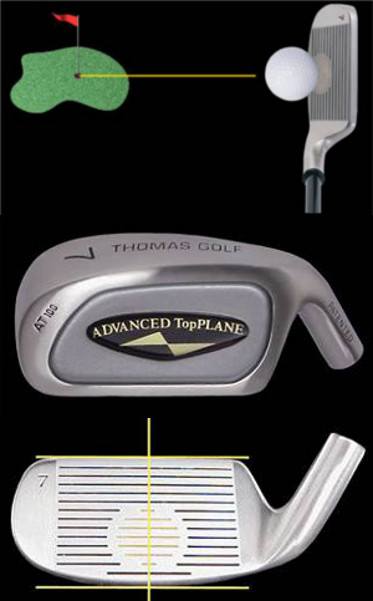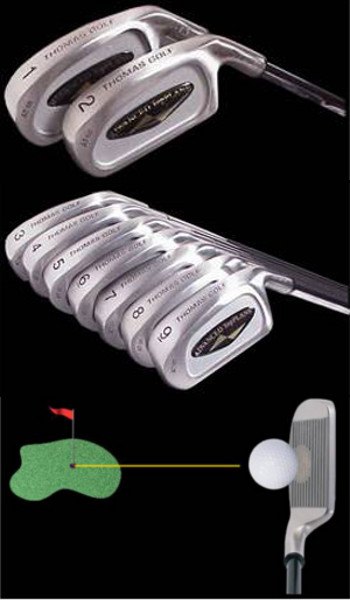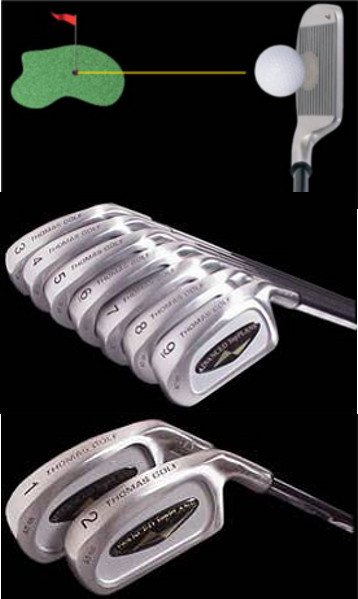
The term “offset” describes a golf club with a face that's set slightly behind the hosel (neck), instead of aligning directly with the shaft. Offset is clearly visible when looking down at the clubhead or viewing it face-on, and some clubs have more offset than others – even within the same set.
Offset is an ingenious innovation that gives golfers an extra split-second to turn the clubface from open to square at impact. It's most often built into “game-improvement” golf clubs for mid- to high-handicap players
The longer the club, the harder it is to square up. That's why many sets feature “progressive offset,” meaning the amount of offset gradually decreases the shorter the clubs become. For example, the 4-iron has slightly more offset than the 5, and so on through the wedges.
Golf clubs with progressive offset offer more forgiveness in the long irons, where it's needed most. Since most golfers are fairly proficient with the short irons, there's no need for much offset in the 8-iron and up. In fact, too much offset can cause shots to stray left while disrupting the player's timing.
Among the companies making progressive offset clubs is Thomas Golf, which offers free custom fitting on its website (www.thomasgolf.com).

Progressive Offset Irons - Help Where Golfers Need It Most
Golf is a hard game – but then again, you already know that. Anyone who has played even a few holes of golf clearly understands the tremendous challenge associated with playing this great game. Scoring well on the golf takes take a comprehensive understanding of a number or areas, including swing mechanics, course management, equipment, and more. If you are deficient in even one of the aspects of the game, you will never be able to live up to your full potential.
Equipment is an area of golf that receives a lot of attention due to manufacturers constantly marketing their products to the golfing public. However, since most of the exposure that the average golfer has to equipment is through marketing, it is hard to know what to believe and what is just noise. Obviously, the club companies want you to buy as many new clubs as possible, so each product that hits the market is billed as the latest and greatest. While you certainly don't need to buy every new club that comes out, it is important to understand the basic design elements that go into golf clubs so you can select the ones that best suit your swing.
One of those design elements is offset. It is easiest to think about offset as the distance between the shaft of the club and the leading edge of the club face. Usually this is a design feature that is seen in irons, but offset woods are also available from some manufacturers. When a club is offset, the face is set back slightly from the hosel (the part of the club where the shaft and club head come together). The purpose of this design is simple – to give the golfer a split second longer to square the club face prior to impact. When the club face is set behind, you will feel like the club is arriving at the ball just a fraction of a second before it actually does. As the club face continues to turn to the left (for a right handed golfer), that minor offset may be just enough time to get the club square and produce a quality shot.
Most often, offset clubs are used by golfers who struggle with a slice. If you have trouble with the ball curving to the right on most of your shots, a set of offset clubs could help to lessen that problem. You probably won't see your slice turn into a nice draw, but the offset could lead to less of a slice and a more playable ball flight.
Some iron sets have a consistent offset, where the amount of offset used in the design of the clubs remains the same from one iron to the next. However, since the longer clubs are the ones that are more likely to fade off target, many iron sets are designed with progressive offset. In this case, the offset of the four iron or five iron is going to be significantly greater than the offset with a pitching wedge. In many ways, this style is the best of both worlds – you get the forgiveness of the large offset in the long irons, while you get the control and clean look of less offset in the short clubs. Since you really don't need to worry about slicing a pitching wedge, there isn't much to be gained by having a large offset at that point in your set.
Any instruction contained below is based on a right handed golfer. If you play the game left handed, please take a moment to reverse the directions as necessary.

The Challenge of the Long Irons
Most amateur golfers, if given the chance, would probably toss their long irons out of the bag and leave them in the trunk in favor of just about any other options. Why do most golfers hate their long irons so much? Quite simply, they are hard to hit. Long irons have longer shafts than short irons (obviously) and less loft, both elements which makes it harder to strike a quality shot. In order to get a long iron shot up off the ground and flying toward the target, you must hit the sweet spot with plenty of club head speed. Even a minor miss-hit will be magnified when you are swinging a long iron, so your technique must be spot on to achieve the desired result. Hybrid clubs have become so popular in recent years in large part because they have allowed many golfers to leave their long irons at home.
However, even with the challenge of hitting these clubs well-documented, there is still a lot to be said about the ability to strike a beautiful long iron shot. The low, penetrating ball flight that is produced by a long iron is hard to replicate with any other club, as hybrids tend to throw the ball high in the air. If you play on courses that reward the ability to hit low shots – such as those in windy areas – you will want to make friends with your irons. That might sound like an intimidating task, but a set of progressively offset irons will make it significantly easier.
If there is any hint of a slice tendency in your golf swing, the long irons will bring it out and put it on display. When the club moves slightly across the ball at impact from outside to in, the ball will spin from left to right and either a fade or a slice will result. While your swing pattern might create a playable fade with your shorter clubs, that fade can quickly get out of control when you are trying to hit a long iron. With that in mind, using a set of irons that has ample offset in the long irons is a great idea for a large group of amateur players.
It is difficult to get your long irons into a square position at the bottom of the swing for a couple of reasons. First, the length of the club means that you need a longer swing in order to give the release time to take place – and most average golfers don't give the swing the time it requires. Usually, an amateur player will rush through the swing when hitting a long iron, leaving the face open at impact as a result. The challenge of fixing this tempo is a hurdle that many players never clear. Also, reaching a square position at the bottom with a long iron requires great lower body rotation toward the target. This is another area where many players have trouble. Without great timing and a strong leg turn, your long irons are destined to remain open to the line at impact. Therefore, selecting long irons with plenty of offset is a great way to get your club face back in position without having to change your swing mechanics.
A progressively offset set of irons might be your best chance to keep at least a couple of long irons in the bag. Instead of fighting with your non-offset irons over and over again to no avail, test out a set with progressive offset built into the design. Unless you have a wicked slice coming off the face of your current irons, a new set of offset clubs should be enough to bring your ball back much closer to the target on a consistent basis.

Short Irons Are a Different Story
Why don't you need a significant amount of offset in your short irons? Thanks to the loft of these clubs, they are very easy to hit in the general direction of your target. Rarely will you see a short iron shot that is sliced significantly off line, simply because the loft of the club is going to apply most backspin rather than sidespin. Even with a swing that swipes across the ball from outside to in rather dramatically, you will still generate a high shot that fades slightly to the right. In fact, you can still hit the green most of the time with this kind of swing, as long as you get the distance correct.
Since you don't need the offset to help you hit the ball straight when you are dealing with the short irons, it is better to not have it there at all. Offset short irons can be harder to hit because the downward angle of attack you use with these clubs can lead to fat shots. Since the face of the club is trailing the shaft, it is easy to 'stick it in the ground' rather than striking the ball cleanly before taking a divot. Your swing is shallower with a long iron, so this problem is not such a concern. However, on short irons where you need to swing down through the ball, offset irons can easily create fat shots.
Another problem with offset short irons is their appearance. Most golfers find them to be off-putting when they look down at address, as the additional loft only serves to exaggerate the appearance of the offset design. Offset long irons aren't nearly as noticeable, but offset short irons can cause problems from a visual perspective. If you can find a quality set of irons that feature progressive offset, you can avoid the uncomfortable experience of hitting offset short irons while enjoying all of the advantages that the long irons offer to your game.

Why Stick with Long Irons at All?
If you are a serious golfer – or even someone who just plays a few rounds a year – you certainly are aware of the rapid rise in the popularity of hybrid clubs. These are clubs that have properties of both a fairway wood and a long iron, and they hit the market with the intention to clear out long irons from the golf bags of most amateur players. While they have been a huge success, and you should certainly consider adding one or two to your bag, there is no reason to completely give up on long irons. By properly constructing your set, you can make room for both hybrids and long irons, giving you the benefits of each without giving up the other.
There are a number of things that long irons do better than hybrid clubs. Following is a partial list of advantages that long irons have over their hybrid cousins –
- Accuracy. Irons will always be more accurate than woods/hybrids simply because of the design of the club head. You can certainly hit plenty of accurate shots with a hybrid club, but a good swing will leave you with even more control over the ball when you play a long iron. Of course, you have to make a quality swing in order to enjoy that control, but it is there for the taking. This is the big reason that most professional golfers still use long irons (along with a hybrid or two) – they love the control that they offer. If you want to be able to accurately attack the target from long distance, you won't find a club better suited to the job than a long iron.
- Dealing with the wind. If there is one area where hybrid clubs really fall down on the job it is dealing with windy conditions. Hybrids are designed to make it easy to get the ball up into the air – which is great, until the wind comes up and you want to keep the ball down closer to the ground. It can be tough to hit hybrids low, even when you modify your technique by choking down on the club and moving the ball back in your stance. On the other hand, it is easy to bring your long iron ball flight down on command. The shots you hit with your long irons are probably lower in flight to begin with, and a couple of basic adjustments will bring that flight down even lower. If you play your golf in an area that is consistently windy, having long irons in your bag is almost a requirement for good scores.
- Getting out of trouble. Not all long iron shots have to be full swings. Sometimes, the most important shot your long irons will hit all day is a punch out of the trees that gets your ball out of trouble and back in play. Punch out shots are easy to hit with long irons, and something of a challenge with hybrid clubs. Again, it comes down to the design and intent of the club head. Since hybrids are meant to get the ball up into the air, it is hard to keep them down under tree branches and other obstacles when hitting a punch out. Of course, not all courses require punch outs, so think about the courses you play most frequently. Are there trees that will require you to punch back to the fairway from time to time? If so, it is essential to have at least one or two long irons in your bag.
- Refining your swing. There is nowhere to hide when hitting a long iron. Hybrid clubs are great at masking your swing flaws and allowing you to hit reasonably good shots even with bad swings. There is no such forgiveness waiting at the end of your long irons. Even with plenty of offset, you are going to need to make a nice swing in order to hit a good shot. While that puts some pressure on you as a golfer, it also helps you to improve. In order to hit good long iron shots, you will need to consistently work on refining your technique on the driving range. Improving your technique through hard work will allow you to hit better long iron shots, as well as making you a better player overall. Forgiving clubs are great for scoring, but they don't teach you much about your weaknesses.
Hopefully, the points above will be enough to convince you that long irons still deserve strong consideration for a spot in your golf bag. While they might be tough to hit, there are many positives that can be enjoyed when you put these clubs to use. By committing yourself to the practice time required to learn how to use long irons effective, you will make yourself a better overall player.
Of course, you have to have room in your set to include the long irons, so set construction is crucial. The rules of golf only allow for 14 clubs to be used in a given round, and those spots can quickly run out when you start adding up all of the clubs you want to take with you. Consider that basically every golfer will have a driver, three wood, irons six-pitching wedge, a sand wedge, a lob wedge, and a putter. That is ten clubs right off the bat, leaving you only four more spots. If you add a five wood and a five iron, you are now down to just two open slots in the bag. For most players, the best choice will be to then add a hybrid club and a long iron. Depending on the distance you need to fill in your bag, you could pick either a three or four iron, and your hybrid club will likely be slightly more lofted than your five wood. Obviously you can customize this setup for your personal needs, but a set construction along these lines should serve you nicely.

Choosing the Right Progressive Offset Iron Set
Now that you understand why a progressive offset iron set can be so helpful to your game, it is time to think about how you can pick one out when you are ready to make a purchase. The first thing you should know is that golf clubs are a very individual buying decision. Just because a specific set of clubs is popular with some golfers does not mean that it will work properly in your game. You need to try out the clubs you are considering, and be sure to make your own decision. Keep an open mind and pick the clubs that you feel will help you score the best – not the ones that you thought looked cool when you saw them online.
As a first step, determine a price range for your upcoming purchase and eliminate clubs that are too expensive. Also, you might want to eliminate sets that are too cheap. While it would be great to save money, low priced golf clubs usually mean low quality – and you want something that will last for many years to come if you are going to invest time and money into a new set. With your budget set, visit your local golf shop or look around the web to find suitable options.
Next, determine the shaft that you want to have in your set of irons. The shaft that you use is just as important as the club heads, if not more important. If you get the shaft wrong, it doesn't really matter what kind of heads you pick because your performance will never be satisfactory. Take the time to go through a club fitting process and pick out a shaft that can be put into each iron within the set. The shaft is the engine of the club, so don't cut any corners when making this selection.
Finally, don't be afraid to go with your gut instinct when buying the set that will be added to your bag. Sometimes, you will simply find a set of clubs that looks right to your eye. As long as that set fits within your budget and offers the progressive offset you are looking for, go ahead and stick with your gut feeling and natural instinct. You have to trust these clubs to hit shots out on the course when you are feeling nervous or anxious, so they need to be pieces of equipment that you can trust completely.
Progressive offset irons offer plenty of advantages to the average golfer. If you are a player who struggles from time to time with missing the ball to the right of the target, test out a progressively offset set for yourself. While they won't be the correct fit for all players, a set of progressive offset irons can work wonders in the right hands.






